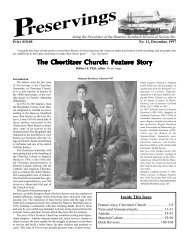Preservings $20 Issue No. 26, 2006 - Home at Plett Foundation
Preservings $20 Issue No. 26, 2006 - Home at Plett Foundation
Preservings $20 Issue No. 26, 2006 - Home at Plett Foundation
You also want an ePaper? Increase the reach of your titles
YUMPU automatically turns print PDFs into web optimized ePapers that Google loves.
Jesus Teaches and Heals the Sick (Mall. 19) (The Hundred Gulden Print).<br />
life in the Netherlands. Schmidt-Degener finds<br />
Christianity in Rembrandt of a preRenaissance<br />
type, an expression which is more universal, as<br />
though sectarian divisions never existed. 3<br />
However, this much we do know about<br />
Rembrandt and the Mennonites: he met and<br />
knew many of them well. For several years<br />
he resided with a Mennonite family; he met<br />
them within the close proximity of his easel,<br />
one of whom was a prominent minister and<br />
leader; he knew some of their aspiring artists<br />
and trained them in his own studio. Thus much<br />
we can say and with un impugnable evidence.<br />
It may be worth our while to bring together<br />
these facts in summary fashion in order to see<br />
th<strong>at</strong> Rembrandt’s contacts were numerous and<br />
significant. At the end of this article an <strong>at</strong>tempt<br />
will be made to compile a list of all the Mennonite<br />
subjects which occur in Rembrandt’s<br />
art. The list here is doubtless incomplete, and<br />
we shall be delighted to have additional items<br />
pointed out. 4<br />
The closest rel<strong>at</strong>ionship Rembrandt had<br />
with Mennonites occurred during his early<br />
years in Amsterdam as an artist, about 1631 to<br />
1635, from the twenty-fifth to the twenty-ninth<br />
year of his life. During this period he lived<br />
with the Hendrick Uylenburgh family in the<br />
Jodenbreestra<strong>at</strong> where he himself l<strong>at</strong>er bought<br />
a house. Uylenburgh was an art merchant and<br />
had bought some pictures from the young<br />
Rembrandt while he still lived in Leiden and<br />
was his “agent” during the time the artist was<br />
establishing a reput<strong>at</strong>ion. Also, while living<br />
with the Uylenburghs, Rembrandt married<br />
Saskia van Uylenburgh, a close rel<strong>at</strong>ive of his<br />
host but a member of the Reformed Church.<br />
They were married June 22, 1634, and the first<br />
year of their wedded life was spent under the<br />
Uylenburgh roof.<br />
The point of special interest here is th<strong>at</strong><br />
Hendrick Uylenburgh was a Mennonite of the<br />
W<strong>at</strong>erlander persuasion. He came originally<br />
from Friesland but had lived <strong>at</strong> Danzig and Krakow<br />
where he became a member of the church.<br />
In Amsterdam as a merchant he maintained his<br />
affili<strong>at</strong>ion with the W<strong>at</strong>erlanders and his family<br />
followed in his footsteps. Thus Rembrandt had<br />
an intim<strong>at</strong>e connection with a devout Mennonite<br />
family during an early stage of his career.<br />
If one recalls how closely Mennonite family<br />
life was guarded, even among the more liberal<br />
W<strong>at</strong>erlanders, one asks on wh<strong>at</strong> arrangement<br />
Rembrandt was accepted in the household for<br />
a four-year period. 5<br />
The first Mennonite subject to be portrayed<br />
by Rembrandt were doubtless members of<br />
the Uylenburgh family. Pretty good evidence<br />
exists to show th<strong>at</strong> the portrait painting done<br />
in 1632, sometimes thought to be Lysbeth van<br />
Rijn, Rembrandt’s sister, is really Maria van<br />
Eyck, the wife of Hendrick Uylenburgh. 6 Much<br />
better known are Rembrandt’s portraits of the<br />
Dutch Mennonite minister, Cornelis Claesz<br />
Anslo. We have two drawings, as well as two<br />
different etchings of this W<strong>at</strong>erlander preacher,<br />
along with the well-known painting of him in<br />
his study conversing with a widow. All of these<br />
pictures d<strong>at</strong>e from 1640-41, when Rembrandt<br />
was <strong>at</strong> the height of his popularity. Anslo, 1592-<br />
1646, was known in Amsterdam as “a very earnest,<br />
pious, upright, and intelligent preacher.”<br />
He must have frequently visited the Uylenburgh<br />
home, since he was the leading W<strong>at</strong>erlander<br />
minister in the town. Rembrandt’s interpret<strong>at</strong>ion<br />
is symp<strong>at</strong>hetic, which may indic<strong>at</strong>e th<strong>at</strong> he was<br />
favorably disposed toward the minister.<br />
Another Mennonite subject of special<br />
interest is th<strong>at</strong> of the Dutch calligrapher and<br />
schoolteacher, Lieven Willemsz van Coppenol.<br />
We have a drawing of “Master Coppenol” and<br />
Lysbeth van Rijn, now claimed to be Maria van<br />
Eyck, wife of Hendrick Uylenburgh, in whose home<br />
Rembrandt lived. Photo credit: Adolph D. & Wilkins<br />
C. Williams Collection, of Fine Arts.<br />
BerlinCornelis Claesz Anslo. Detail from Cornelis<br />
Claesz Anslo and Wife. Photo credit: Kaiser Friedrich<br />
Museum.<br />
One of Rembrandt’s etchings of Cornelis Claesz<br />
Anslo.<br />
32 - <strong>Preservings</strong> <strong>No</strong>. <strong>26</strong>, <strong>2006</strong>
















